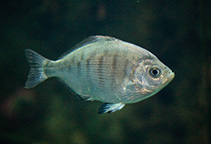http://www.fishbase.org/Summary/speciesSummary.php?genusname=Hyperprosopon&speciesname=argenteum ---> http://192.134.151.83/Summary/speciesSummary.php?genusname=Hyperprosopon&speciesname=argenteum
http://192.134.151.83/Summary/speciesSummary.php?genusname=Hyperprosopon&speciesname=argenteum ---> https://fishbase.mnhn.fr/Summary/speciesSummary.php?genusname=Hyperprosopon&speciesname=argenteum
https://fishbase.mnhn.fr/Summary/speciesSummary.php?genusname=Hyperprosopon&speciesname=argenteum ---> https://fishbase.mnhn.fr/summary/Hyperprosopon-argenteum.html
Hyperprosopon argenteum, Walleye surfperch : fisheries, gamefish

You can
sponsor
this page
Common name (e.g. trout)
Genus + Species (e.g. Gadus morhua)
-

-
About this page
-
Languages
-
User feedbacks
-
Citation
-
Uploads
-
Related species
-


 Walleye surfperch
Add your observation in
Fish Watcher
Upload your
photos
and
videos
Walleye surfperch
Add your observation in
Fish Watcher
Upload your
photos
and
videos
Pictures
|
Videos |
Google image
 Hyperprosopon argenteum
Hyperprosopon argenteum
Picture by
DeCloux, R.
Teleostei (teleosts) >
Ovalentaria/misc
(Various families in series Ovalentaria) >
Embiotocidae
(Surfperches)
Etymology:
Hyperprosopon:
Greek, hyper = over + Greek, prosopon = face, snout of animal (Ref.
45335
)
.
Environment: milieu / climate zone / depth range / distribution range
Ecology
Marine; demersal; depth range ? - 18 m (Ref.
2850
). Subtropical; 52°N - 26°N, 130°W - 113°W
Eastern Pacific: Vancouver Island in British Columbia, Canada to central Baja California in Mexico, including Guadalupe Island (off northern central Baja California).
Size / Weight / Age
Maturity: L
m
?
range ? - ? cm
Max length : 30.0 cm TL male/unsexed; (Ref.
2850
); max. reported age: 6 years (Ref.
56049
)
Dorsal
spines
(total): 8 - 10;
Dorsal
soft rays
(total): 25-28;
Anal
spines
: 3;
Anal
soft rays
: 30 - 35;
Vertebrae
: 33 - 37. Dark blue dorsally, sides and belly silvery with young having narrow golden vertical bars; tips of pelvic fins black; dusky on edge of caudal fin (Ref.
6885
).
Live in surf on sand beaches and over sand near rocks, often around piers. Often occur in dense schools. Feed on small crustaceans. Viviparous, female carries the developing young (Ref.
205
). Usually bear 5-12 young. An important game species.
Life cycle and mating behavior
Maturity
|
Reproduction
|
Spawning
|
Eggs
|
Fecundity
|
Larvae
Viviparous, female carries the developing young (Ref.
205
).
Eschmeyer, W.N., E.S. Herald and H. Hammann
, 1983. A field guide to Pacific coast fishes of North America. Boston (MA, USA): Houghton Mifflin Company. xii+336 p. (Ref.
2850
)
IUCN Red List Status (Ref.
130435
)
Not Evaluated
CITES
Not Evaluated
Not Evaluated
Threat to humans
Harmless
Human uses
Fisheries: commercial; gamefish: yes
FAO - Publication:
search
|
FishSource
|
More information
Countries
FAO areas
Ecosystems
Occurrences
Introductions
Stocks
Ecology
Diet
Food items
Food consumption
Ration
Common names
Synonyms
Metabolism
Predators
Ecotoxicology
Reproduction
Maturity
Spawning
Spawning aggregation
Fecundity
Eggs
Egg development
Age/Size
Growth
Length-weight
Length-length
Length-frequencies
Morphometrics
Morphology
Larvae
Larval dynamics
Recruitment
Abundance
BRUVS
References
Aquaculture
Aquaculture profile
Strains
Genetics
Electrophoreses
Heritability
Diseases
Processing
Nutrients
Mass conversion
Collaborators
Pictures
Stamps, Coins Misc.
Sounds
Ciguatera
Speed
Swim. type
Gill area
Otoliths
Brains
Vision
Tools
Bio-Quiz
|
E-book
|
Field guide
|
Length-frequency wizard
|
Life-history tool
|
Point map
|
Classification Tree
|
Catch-MSY
|
Special reports
Check for Aquarium maintenance
|
Check for Species Fact Sheets
|
Check for Aquaculture Fact Sheets
Download XML
Summary page
|
Point data
|
Common names
|
Photos
Internet sources
AFORO (otoliths) |
Aquatic Commons
|
BHL
|
Cloffa
|
BOLDSystems
|
Websites from users
|
Check FishWatcher
|
CISTI
|
Catalog of Fishes
:
genus
,
species
|
DiscoverLife
|
ECOTOX
| FAO - Publication:
search
|
Faunafri
| Fishipedia |
Fishtrace
| GenBank:
genome
,
nucleotide
|
GloBI
|
Google Books
|
Google Scholar
|
Google
| IGFA World Record |
MitoFish
|
Otolith Atlas of Taiwan Fishes
|
Public aquariums
|
PubMed
| Reef Life Survey | Socotra Atlas |
Tree of Life
| Wikipedia:
Go
,
Search
| World Records Freshwater Fishing |
Zoological Record
Estimates based on models
Preferred temperature (Ref.
123201
): 10.7 - 19, mean 12.8 °C (based on 115 cells).
Phylogenetic diversity index (Ref.
82804
): PD
50
= 0.6250 [Uniqueness, from 0.5 = low to 2.0 = high].
Bayesian length-weight: a=0.01905 (0.00831 - 0.04372), b=2.97 (2.77 - 3.17), in cm total length, based on LWR estimates for this (Sub)family-body shape (Ref.
93245
).
Trophic level (Ref.
69278
): 3.5 ±0.50 se; based on food items.
Resilience (Ref.
120179
): Medium, minimum population doubling time 1.4 - 4.4 years (tm=1; tmax=6).
Fishing Vulnerability (Ref.
59153
): Low vulnerability (20 of 100).
Price category (Ref.
80766
):
Unknown
.
Back to Search
Random Species
Back to Top
Accessed through:
Not available
FishBase mirror site :
localhost
Page last modified by :
mrius-barile
- 20 July 2016
Fatal error
: Uncaught ArgumentCountError: Too few arguments to function checkEcotox(), 1 passed in /var/www/html/summary/speciessummary.php on line 2304 and exactly 3 expected in /var/www/html/includes/speciessummary.lib.php:2579 Stack trace: #0 /var/www/html/summary/speciessummary.php(2304): checkEcotox() #1 {main} thrown in
/var/www/html/includes/speciessummary.lib.php
on line
2579
|